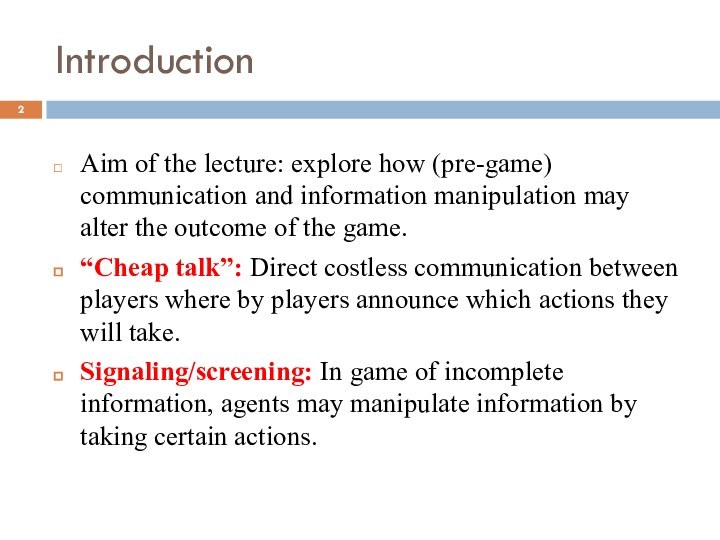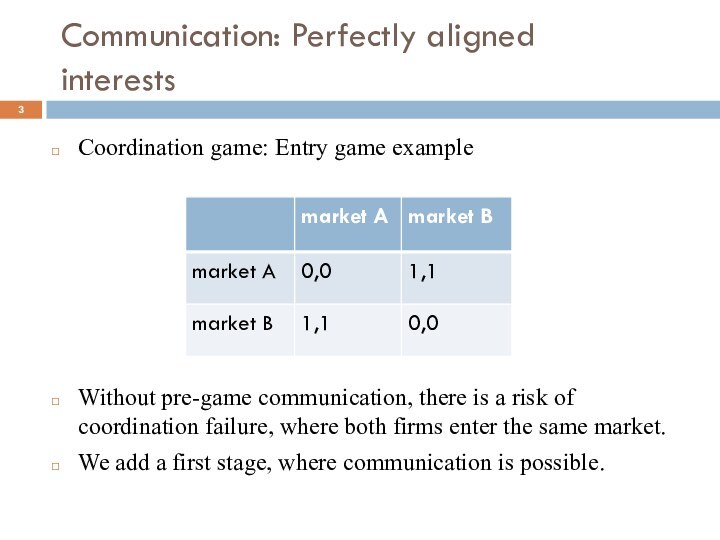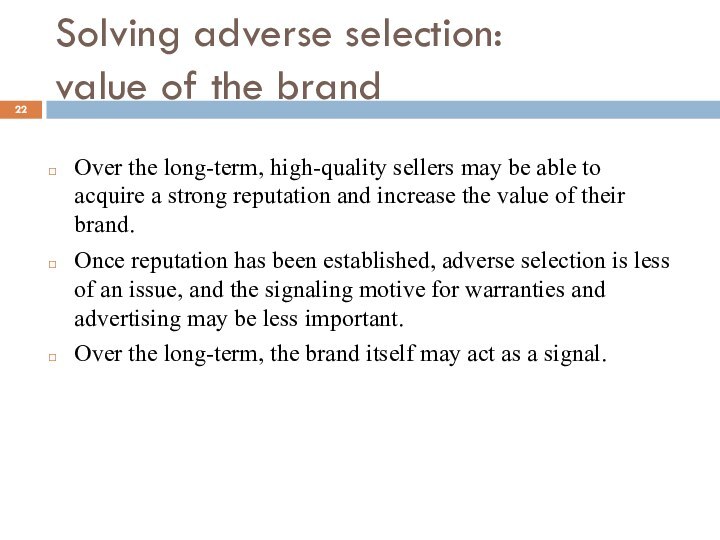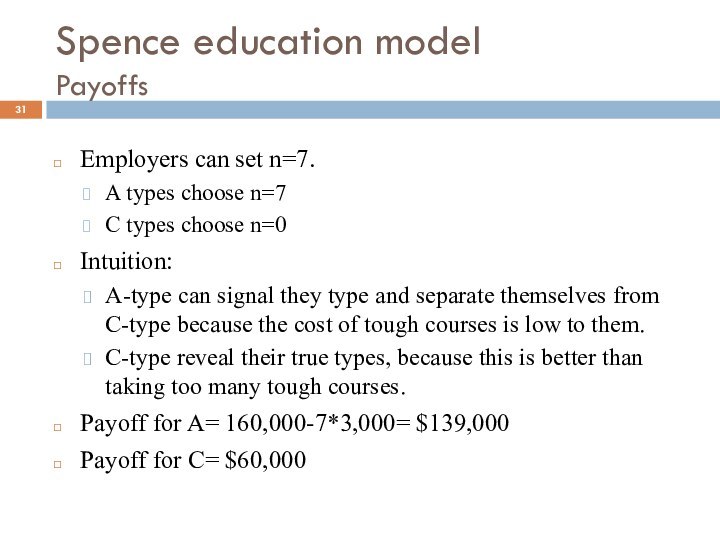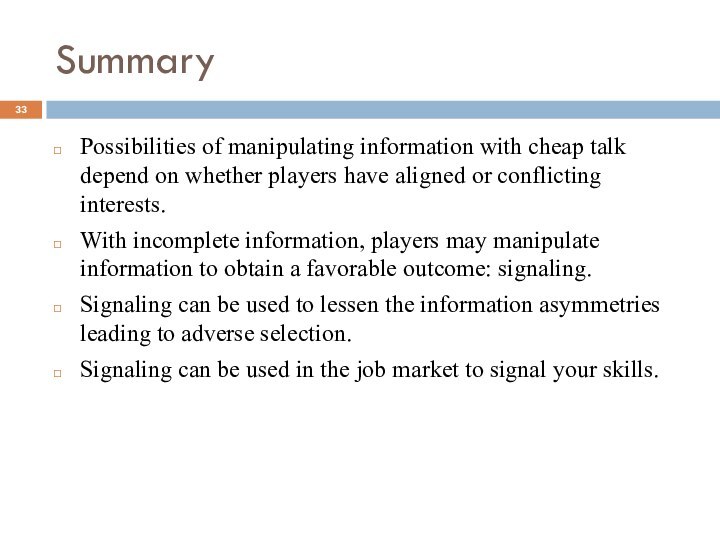Слайд 2
Introduction
Aim of the lecture: explore how (pre-game) communication
and information manipulation may alter the outcome of the
game.
“Cheap talk”: Direct costless communication between players where by players announce which actions they will take.
Signaling/screening: In game of incomplete information, agents may manipulate information by taking certain actions.
Слайд 3
Communication: Perfectly aligned interests
Coordination game: Entry game example
Without
pre-game communication, there is a risk of coordination failure,
where both firms enter the same market.
We add a first stage, where communication is possible.
Слайд 4
Communication: Perfectly aligned interests
Suppose Firm 1 can announce
at no cost its choice of action before Firm
2 gets to choose. The announcement is nonbinding, “cheap talk.”
“I will enter market A”
If Firm 2 believes Firm 1, it will choose B.
By sending a truthful message, Firm 1 can prevent coordination failure.
Firm 1 will be truthful, and Firm 2 has no reason not to believe Firm 1.
Coordination can be easily achieved. Pre-game communication benefits both players.
Слайд 5
Communication: Partially aligned interests
Firm 1 is given the
opportunity to say “I am going to market A”.
Firm 1 benefits from being truthful, and Firm 2 is likely to believe it.
Cheap talk can enable a player to obtain his preferred outcome.
Слайд 6
Communication: Conflicting interests
Example: Employee/manager interactions
The interests are conflicting.
Suppose
the manager has the opportunity to send a message
to announce whether monitoring will take place today.
Manager
Employee
Слайд 7
Communication: Conflicting interests
If the manager says “I will
monitor today”, then the employee will choose “Work” if
he believes the manager.
But then, the manager has no incentive to actually monitor, and is better off doing the opposite of what the signal said. The signal is not truthful.
But if the manager always does the opposite of what he says, the employee will choose to shirk. Knowing this, the manager will monitor…etc.
The employee should just disregard the signal. When players have conflicting interests, pre-game communication is uninformative. (babbling equilibrium)
Слайд 8
Incomplete information
So far we have considered games with
complete information
players know all the rules of the
game - all players, all possible strategies, and payoffs.
In complete information games, pre-game communication is limited to announcing the choice of future actions, i.e. cheap talk.
Manager
Employee
Слайд 9
Incomplete information
In incomplete information games, players may not
have some information about the other players, e.g. about
their type and payoffs.
Producers may not know each others’ costs functions.
An entrant may not know how costly if would be for the incumbent to fight a new entrant.
In a bargaining games, parties may not know each other’s degree of impatience and outside option.
Players know more about themselves than about other players.
Слайд 10
Incomplete information
Possessing superior information is often an advantage,
and allows greater flexibility to adjust to the other
player’s profile
Bargaining game: The optimal offer depends on the other player’s degree of impatience and outside option.
Entry game: the entrant may want to know how tough the incumbent is; the incumbent may want to know how committed the entrant is.
Слайд 11
Information manipulation
Because information can be so important, players
may try to manipulate information, to alter the outcome.
Manipulation of information becomes a strategy, a game within the game.
Unlike cheap talk, signaling and screening is not costless.
Informed players
Uninformed players
Screening
Signaling
Слайд 12
Signaling: The better-informed attempts to signal something about
his type.
Reveal information truthfully, e.g. reveal that you are
patient in a bargaining game.
Reveal misleading information, e.g. hide the fact that you are impatient.
Screening: The less-informed player tries to elicit information and filter truth from falsehood
Employer wants to find out how hard-working its employees are.
Consumers wish to learn if a seller is trustable or not.
Signaling/screening
Слайд 13
Adverse selection and signaling:
the lemon problem
Market for
second-hand cars:
Two types of cars.
Good cars: valued at
$12,500 by the seller
Bad cars: valued at $3,000 by the seller
The potential buyer is willing to pay:
$16,000 for a good car
$6,000 for a bad car (the lemon)
Depending on bargaining power of the two players, the price of the good car will between $12,500 and $16,000. The price of the bad car between $3,000 and $6,000.
Слайд 14
The lemon problem: Asymmetric information
Information is asymmetric: Sellers
know the value of the car, but buyers don’t.
Sellers
of good car would like to indicate that their cars are good, but so do sellers of bad cars. Direct communication is not credible, and buyers remain uninformed.
When quality is unobservable, there can only be one price p for both types of cars.
Слайд 15
The lemon problem: Asymmetric information
In the population of
cars,
A fraction f is of good quality.
A fraction 1-f
is of bad quality.
For the buyer, the expected value of the car purchased is:
16,000f+6,000(1-f)=6,000+10,000f
He will buy the car if:
6,000+10,000f>p
The seller of a bad car will sell if p>3,000. The seller of a good car will sell if p>12,500.
Слайд 16
The lemon problem: Condition on f
To meet the
requirements of all sellers and buyers:
6,000+10,000f>p>12,500
i.e f>0.65, more than
65% of cars are of good quality.
If f>0.65, the expected value of a random car is more than 12,500. Buyers are willing to pay more than 12,500 for a random car, and sellers of good cars will agree to sell.
If f<0.65, the expected value of a random car is less than 12,500. Buyers are not willing to pay more than 12,500 for a random car, and sellers of good cars will not agree to sell.
buyer
seller
10,000f>12,500-6,000
Слайд 17
The lemon problem: adverse selection
When f
an adverse selection problem. Sellers of good cars will
drop out, and only low quality cars will remain on the market.
Potential buyers will recognize this, and pay at most 6,000. Bad cars drive the good cars out.
More generally, because of asymmetric information, producers of high quality products may not expect proper profit, so will not participate in the market.
Слайд 18
Solving adverse selection: warranties
Adverse selection originates from information
asymmetry. Cheap talk is not going to work. Sellers
of high quality cars may signal high quality using warranties.
If the product is faulty of damaged, the seller will replace it.
Suppose that buyers perceive any car with a warranty to be of good quality, and any car without a warranty to be of bad quality.
Suppose that:
For sellers of good cars, the cost of offering warranties is $0. Good cars never fail.
For sellers of bad cars, the cost of offering warranties is $11,000. Low quality cars are more likely to fail.
Слайд 19
Solving adverse selection: warranties
Sellers of good cars will
choose to offer a warranty:
Costs $0.
With warranty they can
sell the car for $16,000, without warranty they can sell it for $6,000.
Sellers of bad cars will choose not to offer a warranty:
Costs $11,000.
With warranty they can sell the car for $16,000, without warranty they can sell it for $6,000. (difference of $10,000)
Слайд 20
Solving adverse selection: warranties
Sellers of good cars can
use warranties to credibly signal the quality of the
car. ? Signaling
Signaling works because good quality producers provide warranties which low quality producers cannot imitate.
Warranties act as a “separating mechanism”. Whether warranty is offered depends on the quality of the car.
Слайд 21
Solving adverse selection: advertising
Sellers of high-quality products advertise
to signal the quality of their products.
For advertising
to be worthwhile, consumers must buy the product repeatedly.
Low-quality sellers do not find it worthwhile to advertise
High-quality sellers find it worthwhile to advertise
It is not the advertising message itself that is effective in convincing consumers. Rather, the simple fact of advertising signals that the product must be of high quality.
Слайд 22
Solving adverse selection:
value of the brand
Over the
long-term, high-quality sellers may be able to acquire a
strong reputation and increase the value of their brand.
Once reputation has been established, adverse selection is less of an issue, and the signaling motive for warranties and advertising may be less important.
Over the long-term, the brand itself may act as a signal.
Слайд 23
Signaling in the labor market:
Spence education model
What credible
signal can be used to convince
employers that
you are highly skilled and they should
hire you?
Spence argues that attending university, and taking tough courses can be used to signal skills.
Consider an employer and two types of potential workers (students):
Able (A), Challenged (C).
Employers are willing to pay $160k for A type and $60k for a C type. The student’s type is not observable to the employer.
Слайд 24
Spence education model
Setting
What each player tries to achieve:
Employer:
find out students’ types.
Able students want to separate themselves
from the challenged.
Challenged students want to mimic able students.
Cheap talk is not credible, all students will claim to be able.
Able students may use signaling strategies
Слайд 25
Spence education model
Setting
Key assumption: Able students are
more
willing to take difficult courses
than challenged students
For
A-type: cost of each tough course is $3,000 (low risk of failing the course)
For C-type: cost of each tough course is $15,000
Слайд 26
Spence education model
Hiring policy
Consider the following employer’s policy:
Any student taking more than n tough courses is
paid $160,000.
Any student taking less than n tough courses is paid $60,000.
Assumption of the employer:
Any student taking at least n tough courses is assumed to be type A.
Any student taking less than n tough courses is assumed to be type C.
Can this assumption be justified?
Слайд 27
Spence education model
Hiring policy
A-type will try to take
many tough courses to signal their ability, but so
will C-type. However, taking courses is more costly for C-type.
The employer assumption that only A-type will select to take n course may be correct if it is too costly for C-type to take n tough courses.
Слайд 28
Spence education model
Incentive compatibility
C-type may “reveal their type”
and take 0 tough course. ? they are paid
$60,000.
C-type may take n tough courses are pretend to be A-type:
? $160,000-$15,000n
C-type prefer revealing their type to taking n tough courses if:
Слайд 29
Spence education model
Incentive compatibility
A-type prefer take n tough
courses and prove their type if:
In order to separate
the two types:
The value of n must be set between 6.67 and 33.33.
A-type are willing to take more than n tough courses
C-type prefer taking less than n tough courses
Слайд 30
Spence education model
Incentive compatibility
100k
Cost for A types
Cost for
C types
6.67
33.33
n
Слайд 31
Spence education model
Payoffs
Employers can set n=7.
A types choose
n=7
C types choose n=0
Intuition:
A-type can signal they type
and separate themselves from C-type because the cost of tough courses is low to them.
C-type reveal their true types, because this is better than taking too many tough courses.
Payoff for A= 160,000-7*3,000= $139,000
Payoff for C= $60,000
Слайд 32
Spence education model
Implications
A positive relationship between years of
education and wages does not necessarily show that education
improve skills.
Instead, education can act as a screening device used to identify the ability of job candidates.
Go to university to signal your ability, go to the best universities to send an even stronger signal on your ability.

